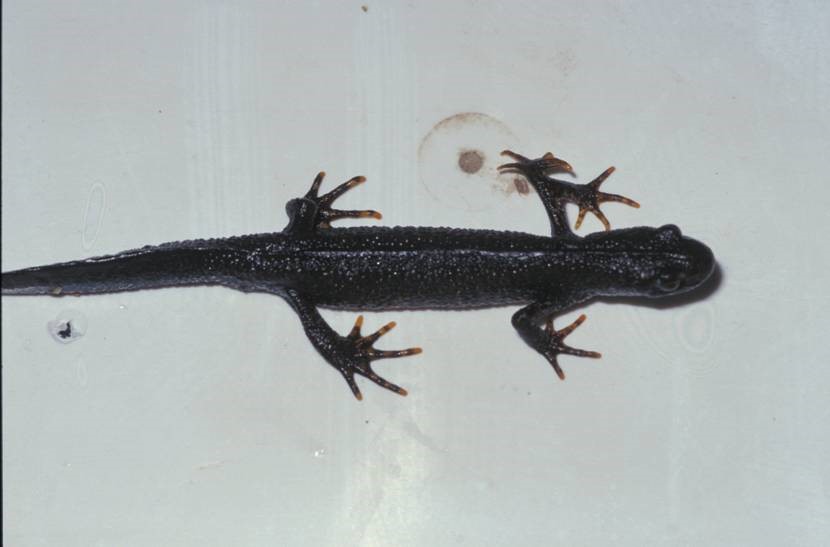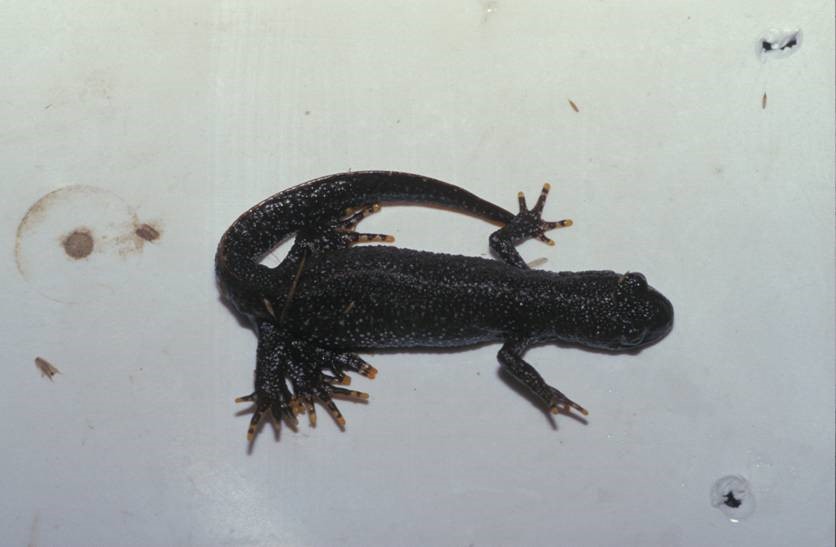Agent
Malformations are deformities that are caused by environmental factors which prevent normal anatomical development, especially during the larval life-stage. As a result, affected animals can develop too many, or not enough, of certain body parts. Internal organs can be affected but amphibian malformations noticed by the public are usually those affecting external body parts, such as digits, limbs or the tail (in newts & salamanders). A variety of agents are known to cause malformations in amphibians, including pollutants, parasites, nutritional deficiencies and injury during development. The relative importance of these as a cause of amphibian malformations in Great Britain is unknown.
Species affected
Globally, amphibian malformations have been reported in a wide range of species of frogs, toads, newts and salamanders. Species known to have been affected in Great Britain include the common toad (Bufo bufo) and the great crested newt (Triturus cristatus).
Signs of disease
Amphibian malformations usually involve missing, extra or misshapen limbs (e.g. see Figure 1), but any body part(s) can be affected, including the head, eyes and tail. Usually only one body part is affected in any one animal.
Great crested newts (Triturus cristatus) with malformations:
(Left) This animal has developed two front left lower limbs and feet.
(Right) This animal has developed three right hind lower limbs and feet.
(Photo credit: Zoological Society of London.)
Disease transmission
There is no single recognised cause of amphibian malformations. In North America, amphibian malformations have been associated with the parasite Ribeiroia ondatrae, which can infest the developing limbs of larval amphibians, causing malformations to develop. Ribeiroia ondatrae is transmitted through water bodies via a complex life cycle involving amphibians, water snails and birds. Thus far, however, R. ondatrae has not been reported outside North America.
Distribution
Amphibian malformations have been reported from across the globe, with most reports coming from North America. In Great Britain, reports of amphibian malformations are sporadic, very infrequent and usually affect only individuals or small numbers of animals at any one time.
Risk to human health
No known risk to human health.
Risk to domestic animal health
No known risk to domestic animal health.
Diagnosis
It can be difficult to distinguish between amphibian malformations and other causes of deformity, such as predation (e.g. when a predator removes a leg, but the animal survives and recovers). Sometimes, additional tests, such as radiography (i.e. X-rays), are required to confirm the presence of a true malformation.
Diagnosing the cause of amphibian malformations can be very difficult. This is because malformations occur during the development (tadpole) stage, so by the time malformed amphibians are found, the causative agent might have disappeared. Also, as a single causative agent for amphibian malformations has not been identified and many of those (e.g. some pollutants) can be difficult and expensive to detect, it is often not possible to find a definitive cause.
If you wish to report finding a dead amphibian, or signs of disease in amphibians, please visit www.gardenwildlifehealth.org. Alternatively, if you have further queries or have no internet access, please call the Garden Wildlife Health vets on 0207 449 6685.
Control and prevention
Once they have developed, amphibian malformations cannot be treated.
Further information
‘What causes deformities in frogs, toads, and other amphibians?’:
https://www.usgs.gov/faqs/what-causes-deformities-frogs-toads-and-other-amphibians?qt-news_science_products=0#qt-news_science_products
Scientific publications
Koleska D, Jablonski D (2016) Two cases of unclear hindlimb malformation in Bombina variegata. Ecologica Montenegrina 9:56–58. biotaxa.org/em/article/view/27901/25527
Taylor B, Skelly D, Demarchis LK, Slade MD, Galusha D, Rabinowitz PM (2005) Proximity to pollution sources and risk of amphibian limb malformation. Environmental Health Perspectives 113:1497–1501. doi.org/10.1289/ehp.7585
Johnson, PTJ, Chase JM (2004) Parasites in the food web: linking amphibian malformations and aquatic eutrophication. Ecology Letters 7:521–526. doi.org/10.1111/j.1461-0248.2004.00610.x
Kiesecker JM (2002) Synergism between trematode infection and pesticide exposure: A link to amphibian limb deformities in nature? Proceedings of the National Academy of Sciences of the United States of America 99:9900-9904. doi.org/10.1073/pnas.152098899
Meteyer, C.U. (2000) Field guide to malformations of frogs and toads with radiographic interpretations. Biological Science Report: https://pubs.er.usgs.gov/publication/53882
Acknowledgements
Current funding for the GWH comes in part from Defra, the Welsh Government and the Animal and Plant Agency (APHA) Diseases of Wildlife Scheme (DoWS) http://apha.defra.gov.uk/vet-gateway/surveillance/seg/wildlife.htm; and from the Esmée Fairbairn Foundation, the Universities Federation for Animal Welfare and the Garfield Weston Foundation.
Disclaimer
This fact sheet was produced by Garden Wildlife Health (GWH) for information purposes only. The GWH will not be liable for any loss, damage, cost or expense incurred in or arising by reason of any person relying on information in this fact sheet.
Date of factsheet update:
May 2020


